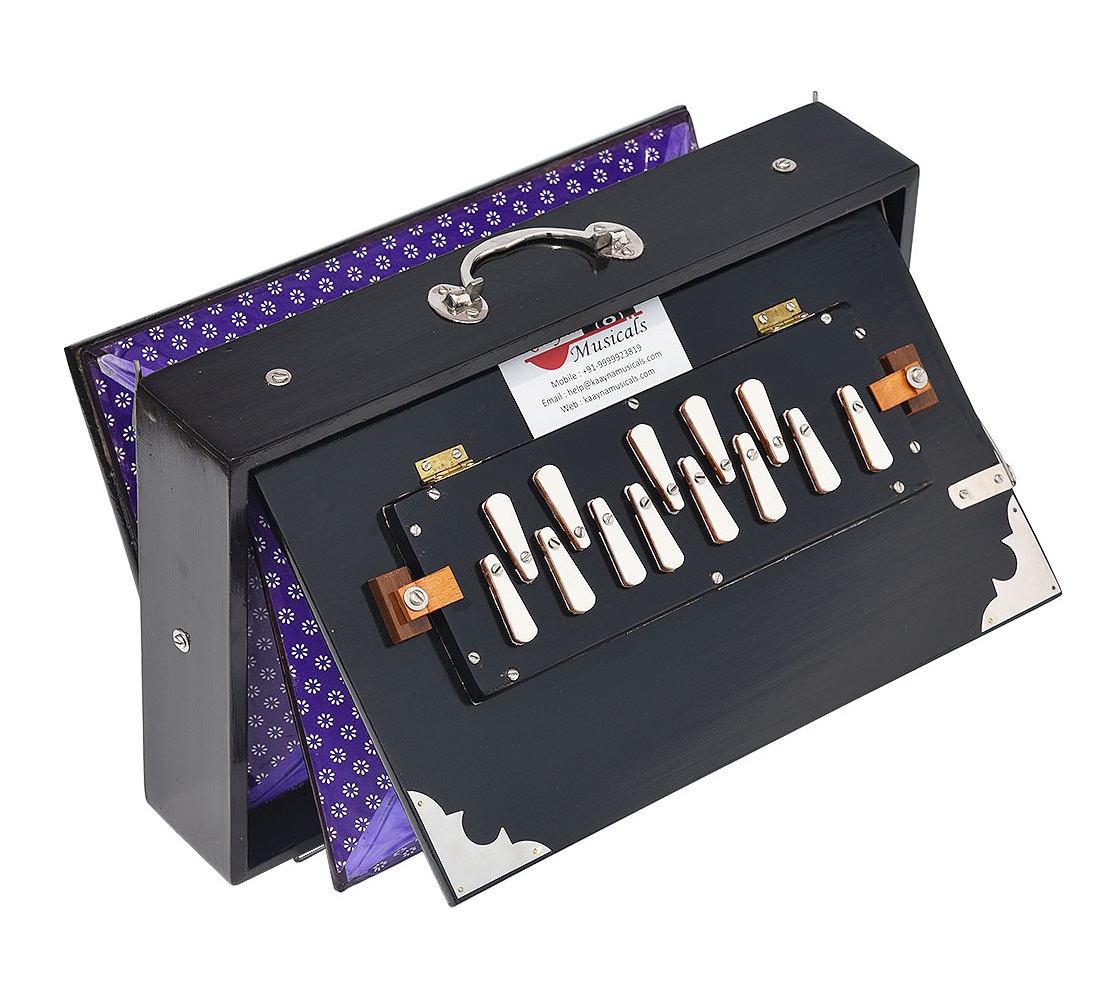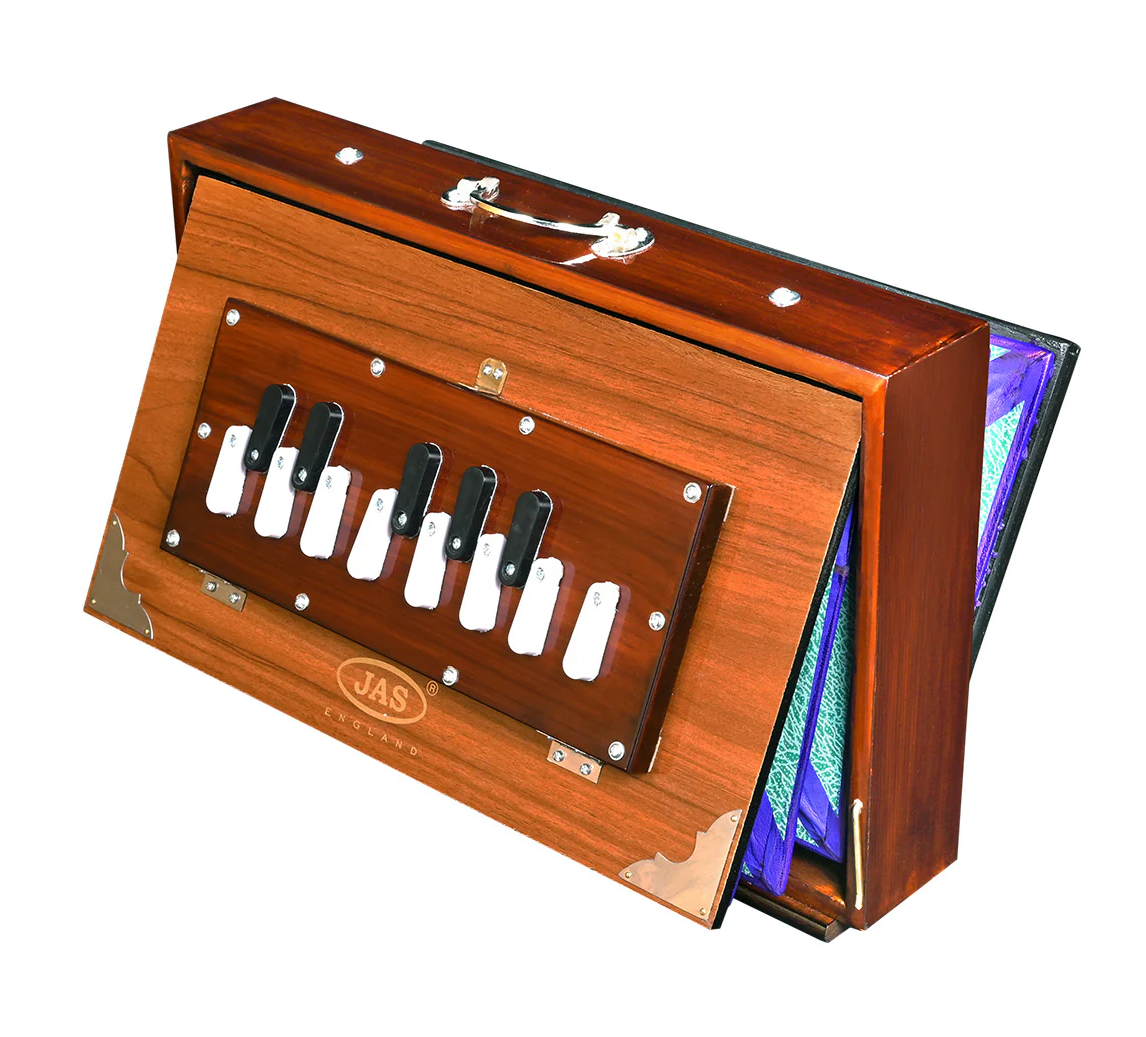Shruti Box
Keyboard Instruments
Asia
Between 1001 and 1900 AD
Video
The Shruti Box is a traditional Indian musical instrument primarily used to produce a continuous harmonic drone. It is similar in function to a harmonium but lacks keys and produces sound through a set of tuned reeds. The player operates the instrument by manually opening and closing bellows to maintain airflow, generating a steady, harmonic tone.
The Shruti Box is widely used in classical Indian music, devotional singing, and contemporary fusion music, providing a fundamental tonal foundation for other instruments and vocals. The Shruti Box falls under the category of aerophones, as it produces sound through the vibration of air passing through reeds. It is a free-reed instrument, meaning the reeds vibrate freely without needing a pipe or resonator. This instrument is closely related to the harmonium, which is also a free-reed aerophone, but the Shruti Box is designed exclusively for continuous drone rather than melodic play.
Historical Background
The Shruti Box has its origins in the Indian subcontinent, likely emerging in its current form in the 19th or 20th century. However, its concept can be traced back to earlier Indian drone instruments such as the tanpura, which serves a similar function of providing a constant harmonic background. The Shruti Box evolved as a portable and convenient alternative to traditional drone instruments, making it especially popular in vocal practice and solo performances. It was influenced by European free-reed instruments introduced to India during the colonial era, particularly the harmonium, which was modified to suit Indian classical music traditions.
Materials Used
Shruti Boxes are typically crafted from high-quality wood, such as teak or pine, to ensure durability and resonance. The reeds inside the instrument are made of brass or copper, materials chosen for their ability to produce rich and stable tones. The bellows, essential for airflow control, are usually constructed from layers of cloth and leather or synthetic materials to ensure flexibility and airtight performance. Some modern versions incorporate plastic components, but traditional wooden designs remain the most preferred for their acoustic quality.
Types of Shruti Boxes
Shruti Boxes come in different designs based on their range and size. The most common types include:
Standard Shruti Box: Features a range of 12 to 13 notes, covering a single octave, making it suitable for most vocalists and instrumentalists.
Compact or Travel Shruti Box: A smaller, lightweight version designed for portability, often used by traveling musicians and practitioners of meditation and chanting.
Electronic Shruti Box: A modern digital adaptation that eliminates the need for manual bellows, allowing for consistent and adjustable drone production with electronic tuning capabilities.
Double Reed Shruti Box: Features two sets of reeds per note, enhancing the richness and depth of the sound produced.
Characteristics
The Shruti Box is known for its simple yet effective design and its ability to produce a sustained drone with little effort.
The Shruti Box provides a continuous, unbroken sound essential for classical and meditative music. Most models allow players to change the pitch by opening or closing different reed valves, usually tuned in just intonation to align with the natural harmonic series. Unlike electronic drone machines, the Shruti Box requires manual operation of the bellows, giving the player dynamic control over volume and intensity. The traditional wooden construction keeps the instrument relatively light, making it easy to carry and use in various settings. The wooden body and metal reeds work together to create a warm, full-bodied sound ideal for accompanying vocals and instruments.
Sound Production
The Shruti Box generates sound through the vibration of free reeds, activated by air pressure from the bellows. When the player pushes the bellows, air flows over the selected reeds, causing them to vibrate and produce a sustained tone. The reeds are precisely tuned, ensuring a stable pitch and a rich harmonic output. Because the reeds vibrate freely without a pipe to modify the tone, the sound of the Shruti Box remains relatively pure and unaltered by external factors.
Playing Methods
Playing the Shruti Box is relatively simple, making it accessible even to those without formal musical training. The primary techniques involve:
The player continuously moves the bellows with one hand to maintain a steady airflow. Different notes are activated by opening or closing small levers on the front of the instrument. Adjusting the force and speed of the bellows influences volume and intensity. Players can create different harmonic textures by selecting multiple reeds to sound simultaneously, adjusting the drone’s color and depth.
Role in Music and Genres
The Shruti Box plays a crucial role in several musical traditions and genres, including:
1. Indian Classical Music: In Hindustani and Carnatic music, the Shruti Box is used as a drone instrument, providing a constant pitch reference for vocalists and instrumentalists. It helps in maintaining pitch accuracy and enhances the depth of ragas by reinforcing the tonal foundation.
2. Folk and Devotional Music: The instrument is widely used in bhajans, kirtans, and Sufi music, where it provides a rich, immersive sound that supports vocal chanting. Its ability to sustain a drone makes it an essential element in religious and spiritual gatherings.
3. Meditation and Sound Healing: The calming, continuous drone of the Shruti Box is known to facilitate deep relaxation, mindfulness, and meditative states. Sound healers and yoga practitioners often incorporate it into their sessions to create an atmosphere of tranquility and focus.
4. World and Fusion Music: Beyond Indian music, the Shruti Box has found its way into Western folk, ambient, and experimental music. Artists from various backgrounds integrate it with different instruments to create unique soundscapes.
5. Theater and Storytelling: In some traditional and contemporary theatrical performances, the Shruti Box is used to create an atmospheric backdrop, adding an emotional layer to storytelling and performances.
Comparisons with Other Drone Instruments
While the Shruti Box serves a similar function to other drone instruments, it differs in design and operation:
Tanpura: Produces a more resonant and layered drone but requires more skill to play.
Harmonium: Has a keyboard and is used for melodic accompaniment, unlike the Shruti Box’s pure drone function.
Bagpipes: Generate a continuous drone but involve a more complex playing technique.
Didgeridoo: A wind instrument producing a sustained tone but differs in mechanics and cultural background.
Cultural Significance
The Shruti Box holds cultural and spiritual significance beyond its musical function. In Indian traditions, the concept of shruti (meaning “that which is heard”) refers to the sacred, unchanging essence of sound in Vedic philosophy. The Shruti Box, by providing a steady drone, symbolizes the continuity of sound and serves as a meditative tool that helps practitioners connect with deeper spiritual states. It is widely used in yoga, mantra chanting, and therapeutic sound healing practices. The instrument has also gained recognition in Western music circles, where it is valued for its simplicity and atmospheric qualities.
The Shruti Box is a remarkable instrument with deep historical roots and a profound role in both traditional and contemporary music. Its ability to produce a continuous drone makes it an essential tool for classical Indian music, meditation, and world music fusion. With its simple yet effective design, it remains a beloved companion for vocalists, instrumentalists, and spiritual practitioners alike. Whether in a temple, a concert hall, or a meditation retreat, the Shruti Box continues to captivate listeners with its soothing, resonant tones, proving its enduring relevance across cultures and musical traditions.
FAQ
What are the key features of a Shruti Box?
A Shruti Box is a small, hand-pumped reed instrument that produces a continuous drone sound. It usually has wooden construction with metal reeds, offering rich harmonic overtones. The pitch can be adjusted using levers or switches. It is lightweight and portable, making it ideal for accompaniment.
How is a Shruti Box used in music?
The Shruti Box is primarily used to create a steady drone for Indian classical, folk, and meditation music. It provides a tonal reference for vocalists and instrumentalists. It is commonly used in practice sessions and performances, especially in Hindustani and Carnatic traditions. Musicians also use it for sound healing and meditation.
What compositions commonly feature a Shruti Box?
Shruti Boxes are used in classical vocal performances, devotional chants, and fusion music. They provide a harmonic base for Indian ragas, Sufi songs, and folk traditions. Many contemporary musicians blend it with electronic music and Western compositions. It is also used in yoga and meditative soundscapes.
 Links
Links
References
Other Instrument
Categories



















